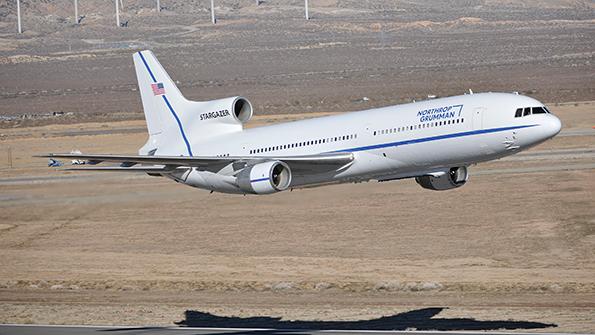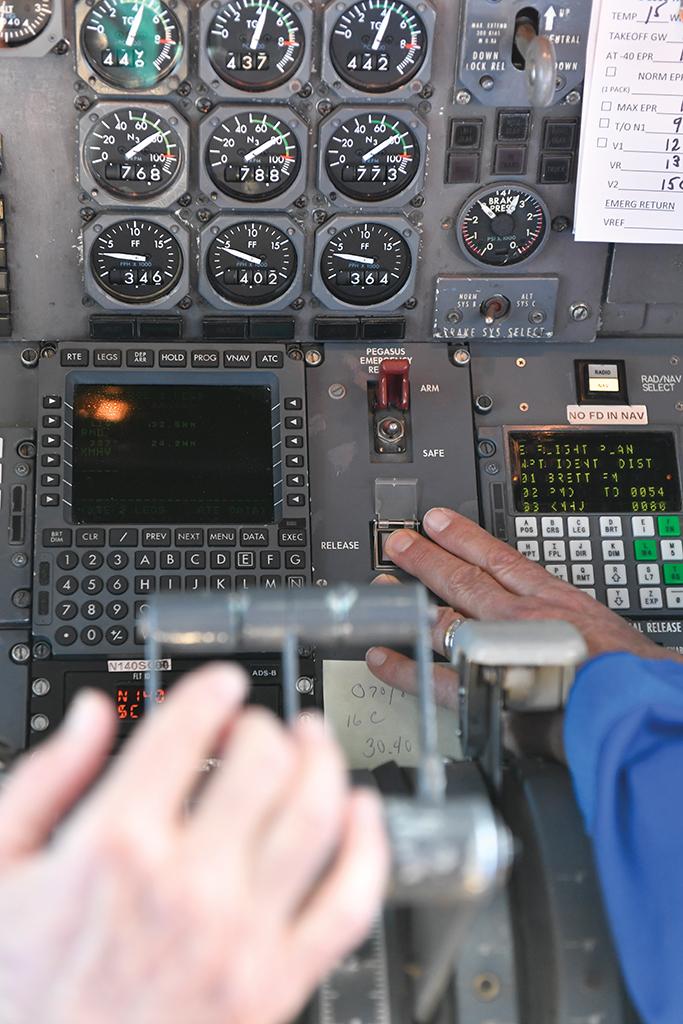
Aviation Week was invited to join a Lockheed L-1011 TriStar training sortie, which included a demonstration of the main procedures involved in a typical air launch. The flight began with a spirited departure from Runway 12 at the Northrop Grumman Stargazer’s Mojave Air and Space Port base.
Turning to the north and climbing quickly over the Tehachapi Mountains, it was difficult to believe the acceleration and agility of the trijet—the prototype version of which had made its first flight more than 51 years ago from nearby Palmdale, California. Although relatively lightly loaded for our short mission, the difference-maker was the 50,000-lb.-thrust Rolls-Royce RB211-524B4 turbofans with which the Stargazer had been reengined in 2010.
- Flight demonstrates the L-1011’s complex prelaunch team choreography
- Pilot holds final payload-release control
Replacing the original 42,000-lb.-thrust RB211-22Bs, the more powerful engines have dramatically boosted performance says Ed Dunlap, L-1011 flight operations program manager, who was also flight engineer for our demo flight. “With the -22Bs, after takeoff it was about a 58-min. trek to allow the airplane to get to 31,000-ft. altitude. When we put on these engines, we went out over the ocean to test them at heavy weights, and when we got to 31,000 ft. it didn’t stop. We were at 900 ft. a minute all the way up to 39,000 ft.,” he says.
For the demo mission, Don Walter, chief pilot of L-1011 flight operations, devised a flightpath that approximated a typical launch profile. For airspace and time reasons, the route took us over California’s Central Valley toward Bakersfield rather than into the Stargazer’s more regular haunts in the Pacific test ranges off the coast from Vandenberg Space Force Base. As we checked in with air traffic control, a twice-repeated question of “Say again aircraft type?” from a perplexed controller unfamiliar with the “L-1011” moniker prompted grins from the crew.
Our approach to the launch point was at roughly half the speed and one-third the altitude of a standard mission. Walter’s navigation waypoints were therefore spaced out to replicate the final 12 min. of the sequence in terms of time rather than distance and brought us to the initial point (IP) after approaching downwind from the south and reversing course for the launch. “I’m given the point for launch by the guidance, navigation and control [GNC] team, and my inbound course is the direction the rocket wants to go,” Walter said.
With all the familiarity of a carefully choreographed and much-rehearsed procedure, the crew entered the simulated pattern with Allan Takoushian, L-1011 captain in the right seat, coordinating with the launch conductor. Passing the IP, Takoushian called out “L-7” (launch minus 7 min.) to the launch conductor, using positioning information from an iPad that displayed the calculated time to the launch point—and entry into a “launch box”—based on airspeed, winds, drift and other factors.
A typical box could measure 10 X 40 mi., Walter said, and provides a small margin for launch delay in the event of a last-minute detection of a potential orbital conflict with a crewed or active spacecraft. “We’re doing 8 mi. a minute, so we can go for 4 min. and the launch director can delay the launch—usually by 30 sec. or so—within that period,” he said.

Working with the launch panel operator (LPO), launch operations verified that the range was “green” and good to go, heaters were turned off, and the switch for holding the fin pins was placed in the disengage position. The aft belly camera was then switched on in readiness to monitor the fin sweep test, as Takoushian reported “L-5” on his GPS/inertial navigation system (INS). A final poll for the launch countdown followed, where the launch vehicle team, the range, LPO and launch manager all declared the launch was ready for go.
At L-4, the terminal count began and the launch conductor verified that the launch window was go. The launch team transitioned the rocket from transient to internal power and verified the correct currents and voltages. Takoushian called out L-3 and verified the INS as ready for flight, while the ground and LPO checked to make sure they also saw the INS ready on their consoles.
At the L-2 mark, the LPO verified he was prepared for the fin sweep test, while Takoushian nudged the L-1011 to acquire the launch heading. Shortly after L-1, the LPO activated the fin batteries. “To me, that’s the most crucial part in the last 45 sec. before drop, where you have to ignite the thermal batteries and sweep the fins, because there’s no going back after that,” Takoushian said.
The pins for the starboard, port and rudder fins were retracted in that sequence by the LPO, followed by the fin sweep for each control surface. The LPO then verified with the control team that movement was as expected.
“That’s the time it gets real heart-pounding,” commented Bryan Baldwin, Northrop Grumman Space Systems program manager, who played the LPO role for the demo. “If you don’t get a good sweep, you can try a couple of times to make sure, but then you’re done and you have to abort and come home,” he added.

Following confirmation of a good sweep and verification from the GNC lead in the control room that heading and ground speed were both nominal, the autopilot was switched off and the technical team said it was “go” for launch. The launch conductor verified approval for launch and checked with Takoushian that he was also ready and had heard that communication.
Despite this being a demonstration, the atmosphere on the flight deck was tense as the launch conductor said, “Drop on my mark . . . three, two, one . . . drop!” Takoushian punched the release button, and he and Walter pulled back on the control columns to simulate the sudden pitch up caused by the release of a 52,000-lb. weight.
“There’s a fairly loud clunk and a negative G maneuver because the airplane is going up so fast,” Walter said. For our flight, however, the pullback had the opposite effect, and we were pushed into our seats with positive G as the L-1011 briefly climbed at more than 4,000 ft./min.
After a real launch, the crew would gently bank the aircraft away and observe the rocket climbing on heading before returning to land, but for our demonstration we leveled off and flew back to land on Mojave’s Runway 30.





Comments
Marshall Aerospace of Cambridge, UK made the initial conversation in 1992/1993 as the mothership for the Orbital Science's Pegasus air-launched launch vehicle.
The initial conversion was to carry the 42,000 lb Pegasus up to an 85,000 lb growth vehicle.
Marshal had previously converted L-1011s to tankers for the RAF. Marshall also converted the L-1011 to a low-time maintenance program based on 150 to 200 flight hours a year.
To counter the increased drag of Pegasus the thrust of the original engines was increased by10% at over 30,000 ft by Marshall obtaining Rolls Royce approval to operate above normal rated thrust by agreeing to more frequent engine inspections.
John Chevedden